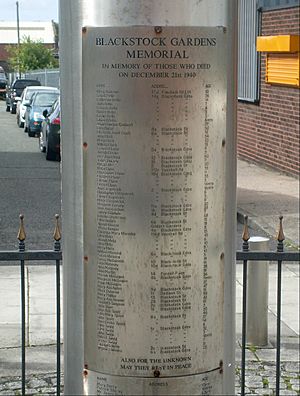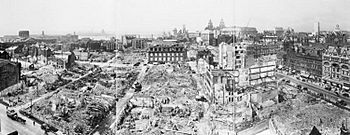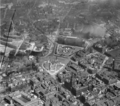Liverpool Blitz facts for kids
Quick facts for kids Liverpool Blitz |
|||||||
|---|---|---|---|---|---|---|---|
| Part of the Strategic bombing campaign of World War II | |||||||
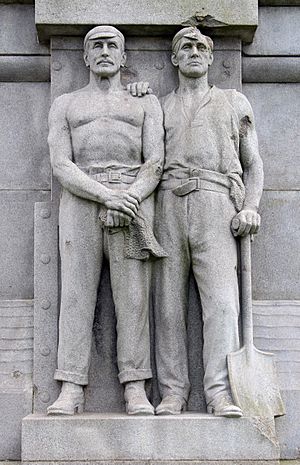 Bomb damage visible on Memorial to Heroes of the Marine Engine Room (photographed 2018) |
|||||||
|
|||||||
| Belligerents | |||||||
| Casualties and losses | |||||||
| Unknown | 4000 | ||||||
The Liverpool Blitz was a period of intense bombing of the English city of Liverpool and its nearby areas. This happened during World War II when the German air force, called the Luftwaffe, attacked Britain.
Liverpool was a very important target for the Germans. It had one of the largest ports on Britain's west coast, along with Birkenhead. This port was vital for bringing supplies into Britain during the war. Because of this, Liverpool was the second most bombed place in the country, after London. About 4,000 people died in the Liverpool area during these attacks.
The Port of Liverpool was Britain's main connection to North America. It played a key role in the Battle of the Atlantic, helping to bring in over 90 percent of all war supplies from other countries. Many other important industries were also located in Liverpool and across the River Mersey in Birkenhead.
Contents
Preparing for the Air Raids
At the start of the war in September 1939, many children were moved out of cities. This was a plan called "Operation Pied Piper." It aimed to keep children safe from German bombs. Between September 1 and 6, about 8,500 children, parents, and teachers left Liverpool. They went to safer, more rural areas in places like Lancashire and Wales.
However, months passed without any major air raids. So, many parents brought their children back home to Liverpool. By January 1940, nearly half of the evacuated children were back in the city.
When the Bombing Began
The first big air raid on Liverpool happened in August 1940. On the night of August 28, 160 German bombers attacked the city.
These attacks continued for the next three nights. After that, raids happened regularly for the rest of the year. There were 50 raids on Liverpool during these three months. Some raids were small, with only a few planes. Others were huge, with up to 300 planes bombing for over ten hours. On September 18, 22 prisoners at Walton Gaol died when bombs hit a part of the prison.
A very heavy raid hit the city on November 28. This was when the worst single incident happened. A bomb hit an air-raid shelter on Durning Road, killing 166 people. Winston Churchill, who was the Prime Minister, called it the "single worst incident of the war."
The air attacks in 1940 reached their peak with the Christmas Blitz. This was a three-night bombing from December 20 to 22.
The Christmas Blitz Attacks
During the Christmas Blitz in December 1940, 365 people were killed. This happened over three nights, from December 20 to 22. Bombs directly hit several air raid shelters. On December 20, 42 people died when a shelter was hit. Another 40 died when a bomb struck railway arches on Bentinck Street, where people were hiding. On December 21, another shelter was hit, killing 74 people.
After the new year, the bombing became less severe for a while.
The May Blitz: A Week of Devastation
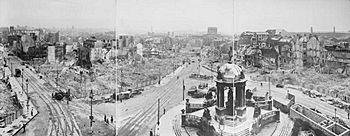
In May 1941, the German air attacks on Liverpool started again, even more fiercely. The city was bombed for seven nights in a row. The first bomb landed in Seacombe, Wallasey, on the Wirral Peninsula, at 10:15 PM on May 1. The worst of the bombing happened from May 1 to May 7, 1941.
During this week, 681 German bombers dropped 2,315 high-explosive bombs. They also dropped 119 other types of bombs, including incendiary bombs (which cause fires). These raids put 69 out of 144 cargo docks out of action. They also caused 2,895 casualties (people killed or injured).
Liverpool Cathedral was hit by a high-explosive bomb. It went through the roof but was stopped by an inner wall. It exploded in the air, damaging many stained glass windows. Another bomb landed on the front steps but did not explode. However, incendiary bombs destroyed equipment nearby.
A serious incident happened on May 3 involving the ship SS Malakand. This ship was carrying ammunition and was docked in the Huskisson Dock. Fires from bombed dock sheds spread to the Malakand. Firefighters tried hard to put out the flames, but they couldn't stop them. A few hours after the raid ended, the ship's cargo of 1,000 tons of bombs exploded. The entire Huskisson No. 2 dock and the surrounding areas were destroyed. Four people were killed. The explosion was so powerful that parts of the ship's metal hull were thrown over 1 mile away into a park. The fire burned for 74 hours.
The seven-night bombing destroyed over 6,500 homes completely. Another 190,000 homes were damaged, leaving 70,000 people without a place to live. 500 roads were closed, and railway and tram lines were destroyed. Water pipes, sewers, gas, electricity, and telephone services were also badly damaged.
Thousands of workers from outside the city and 2,700 soldiers helped clear the debris from the streets. On the night of May 3 and 4 alone, firefighters dealt with 400 fires.
Bootle, a town north of Liverpool, also suffered greatly. Many people died there. One sad event was a direct hit on a Co-op air raid shelter. Many bodies were found and taken to a temporary morgue. This morgue itself was later destroyed by fire bombs, with over 180 bodies inside.
The Times newspaper reported on May 5, 1941, that the Germans said the attack on Liverpool was one of their biggest ever. They claimed hundreds of bombers were used, and that docks, factories, and city centers were hit. They even said one fire was bigger than any seen before during a night attack.
The End of the Blitz
After the May 1941 raids, the German air attacks on Britain became less frequent. This was because Adolf Hitler turned his attention to attacking the Soviet Union.
The very last German air raid on Liverpool happened on January 10, 1942. It destroyed several houses on Upper Stanhope Street. By chance, one of the destroyed houses was number 102. This house had been the home of Alois Hitler, Jr, who was Adolf Hitler's half-brother. It was also the birthplace of Hitler's nephew, William Patrick Hitler. The house was never rebuilt, and the area is now a grassy space.
By the end of the Blitz, German bombs had killed 2,716 people in Liverpool. In nearby towns, 442 people died in Birkenhead, 409 in Bootle, and 332 in Wallasey.
What Remained and What Was Rebuilt

Today, one of the most powerful reminders of the Liverpool Blitz is the burnt-out shell of St Luke's Church. It is located in the city center. An incendiary bomb destroyed it on May 5, 1941. The church was gutted by fire but remained standing. Its prominent position in the city served as a stark reminder of the suffering Liverpool had endured. It is now a garden of remembrance. It honors the thousands of local people who died because of the bombing.
Other important buildings damaged during the Blitz included the Custom House, Bluecoat Chambers, and Liverpool Museum. Many buildings were repaired after the war. However, the Custom House was torn down, which caused some debate.
After visiting Liverpool in May 1941, British Prime Minister Winston Churchill said, "I see the damage done by the enemy attacks, but I also see ... the spirit of an unconquered people."
Images for kids
See also


